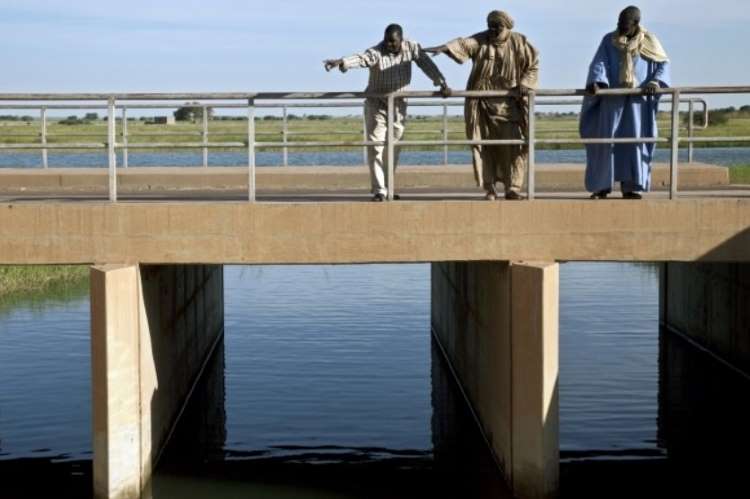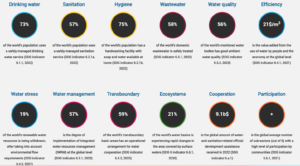
Water is a precious finite resource, and its management is crucial for achieving several sustainable development goals. The 2030 Agenda for Sustainable Development promises to address water-related issues by providing universal and equitable access to safe drinking water and sanitation, reducing pollution, improving water quality, addressing water scarcity, enhancing water use efficiency, ensuring equitable allocation, maintaining integrated water-dependent ecosystems, and promoting social equity through Goal 6 – clean water and sanitation. Water scarcity is one of the most significant societal and economic risks for the coming decades, making water use efficiency imperative to mitigate these risks (Budapest Water Summit, 2016).
Indeed, water use efficiency (WUE) is one of the pillars of sustainable development goals (Callejas Moncaleano et al., 2021). Increasing WUE is strongly linked with food security (SDG 2), economic growth (SDG 8), industrialisation and infrastructure (SDG 9), inclusive cities and human habitats (SDG 11), and responsible consumption (SDG 12) (UN, 2017). Goal 6 of the SDGs specifically targets increasing WUE across all sectors, ensuring sustainable withdrawals and supply of freshwater, and substantially reducing the number of people suffering from water scarcity.
READ I Outdated poverty line creates data dilemma
Water use efficiency and climate crisis
The United Nations High-Level Panel on Water (HLPW) emphasises the interconnectedness of climate change, noting that the impacts of water scarcity on economies and societies will be exacerbated by current climate trends. The HLPW Action Plan outlines actions to improve WUE for resilient economies (agriculture, energy, industry), climate action, and human settlement by encouraging new technologies and policy reforms (UN, 2017). Indicator 6.4.1 of Target 6.4 allows countries to assess the extent to which their economic growth depends on their water resources. This indicator tracks changes in water use efficiency over time, addressing the economic component of Target 6.4 by measuring the value-added per volume of water withdrawn in all water-using sectors.
The global average for water use efficiency is $15/m³, with values ranging from $2/m³ for agriculture-based economies to over $1,000/m³ in highly industrialised, service-based economies (Alba Martinez Salas, 2018). If WUE improves faster than the economic value added in a country, the initiatives are on the right track. This implies that economic growth is not at risk with the current level of water use (FAO and UN Water, 2021). The concept of WUE differs from water productivity as it does not consider the productivity of water used in a given activity as an input to production. Instead, it shows the level of decoupling of economic growth from water use, estimating the extent to which a country’s economic growth relies on the exploitation of its water resources (Alba Martinez Salas, 2018).
Balancing water demand
Balancing competing demands (agriculture, industry, cities, energy, and environment), making the best use of available water resources, and managing changes in supply and demand over time require attention to allocative, productive, and dynamic efficiencies. Action is needed to ensure optimal allocation between different users (allocative efficiency), the minimum amount of water needed for a unit of output (productive efficiency), and sustained improvement in water allocation and use over time (dynamic efficiency) (UN, 2017). The term ‘water use efficiency’ can be interpreted differently depending on the discipline, sectoral outlook, or point of measurement.
Water use efficiency as a concept was first introduced by Briggs and Shantz in 1913, showing the relationship between plant productivity and water use. They defined WUE as the amount of biomass produced per unit of water used by a plant (Hatfield & Dold, 2019). Water efficiency means “doing more and better with less” by obtaining more value with given resources, reducing resource consumption, and minimising the pollution and environmental impact of water use for producing goods and services (UNEP, 2014).
SDG6: A Global status report

The water efficiency index measures the WUE of enterprises using indicators like unit product water consumption, unit value-added water consumption, reuse rate, water leakage rate, and water meter equipment availability. However, there is a problem with reasonably classifying industry categories. The water efficiency index system combines unit product water consumption and unit value-added water consumption (Chen et al., 2023). The widely used methods for measuring WUE include unit water output, value-added unit water output, and total factor productivity (TFP). The latter is the ratio of minimum water consumption to actual water consumption in the measurement area, reflecting the efficiency of water use in industrial and mining enterprises (Zhang et al., 2019).
Including the quality aspect of output water in industrial WUE can improve industrial green levels and competitiveness (Zhao et al., 2022). Improving WUE involves minimising water intensity and maximising the value of water use and allocation decisions within and between sectors for sustainable development. This approach is based on technical, productive, product-choice, and allocative efficiencies (McGlade, 2012).
Recent research on WUE has made significant progress. Popular methods for evaluating WUE include stochastic frontier analysis, the water footprint method, the fuzzy elements method, the comprehensive indicator system, factor decomposition, and data envelopment analysis (DEA). Studies focus on spatial and temporal variations and influencing factors from economic, social, resource endowment, and ecological environment aspects (Zhao et al., 2022).
In India, the Bureau of Water Use Efficiency (BWUE) was established under the National Water Mission in October 2022 to improve WUE by 20%. BWUE promotes efficient water use across various sectors, including irrigation, drinking water supply, power generation, and industries. The ‘Sahi Fasal’ campaign emphasises increasing WUE in agriculture by producing crops that are nutritionally valuable, economically remunerative, and water efficient. The government also promotes the Aviral Dhara and Nirmal Dhara initiatives for continuous and clean flow in the Ganga River (National Water Mission, 2023).
Globally, the OECD and South Korea’s Ministry of Land, Infrastructure and Transport embarked on a policy dialogue to enhance WUE in Korea, focusing on economic instruments, smart water management, and water allocation regimes (OECD, 2024). Australia’s WaterGuide framework assists policymakers in developing strategies for improving WUE. The Water Efficiency Labelling and Standards Scheme (WELS), implemented in 2005, promotes water-saving products and technologies. Other countries, including Colombia and the United States, have also established plans and strategies to improve WUE (Callejas Moncaleano et al., 2021).
Water efficiency benchmarking and labelling empower consumers to make water-efficient choices, driving innovation and improving technology efficiency across industries. In China, a comprehensive assessment of water use in industry, agriculture, urban water use, and environmental water quality ranks different regions, highlighting the importance of efficient water use (Zhang et al., 2019).
The water crisis is often a governance crisis. Effective water governance focuses on WUE across all sectors and supports the achievement of sustainable management goals, especially in the context of climate change. Involving all stakeholders in creating a framework for WUE is crucial to resolving water scarcity issues. It is time for all stakeholders to contribute to improving WUE and ensuring water availability for all sectors.
(The author is Executive-in-charge, of Ferro Alloys and Minerals Division, Tata Steel Ltd. The views expressed in this article are of the author and not necessarily those of the company he is associated with.)
The author is Executive Incharge, Ferro Alloys and Minerals Division, Tata Steel Ltd. The views expressed in this article are of the author and not necessarily those of the company he is associated with.


